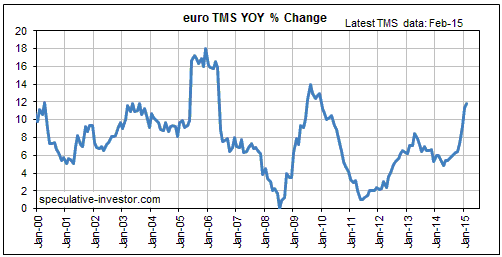This post is a slightly-modified excerpt from a recent TSI commentary.
The monetary data published by the ECB last week showed that the rate of euro-zone TMS (True Money Supply) growth continued to accelerate in February — to a year-over-year rate of 11.8%, from 11.4% in January and ‘only’ 6.4% last October. Here’s a chart that puts the current monetary inflation rate into perspective.

The ECB didn’t begin its new QE program until March, so the above chart doesn’t include any of the effects of this new program. In fact, the effects of the new program probably won’t start becoming apparent until the April monetary data are published in late-May.
In one way, the current situation in Europe is similar to the situation in the US during the final few months of 2012. Back then, the Fed embarked on an aggressive new money-pumping program despite the year-over-year rate of US TMS growth already being in double digits and despite the prices of US stocks and bonds being near multi-year or all-time highs. Now we have the ECB embarking on an aggressive new money-pumping program despite the year-over-year rate of euro-zone TMS growth already being in double digits and despite the prices of European stocks and bonds being near multi-year or all-time highs.
The QE program introduced by the Fed in late-2012 did not help the US economy, but it did inflate a new stock market bubble. It also encouraged stock buybacks at the expense of capital investment, incentivised the continued accumulation of debt at a time when both the private and public sectors were already over-indebted, and fostered an investment boom in the shale-oil industry that’s now in the process of collapsing.
Apart from the specific example of the oil-investment boom, it’s possible that the QE program recently introduced by the ECB will end up having similar effects.
 Print This Post
Print This Post
